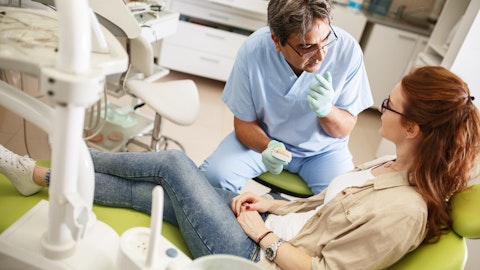In this piece, we will take a look at 30 countries with the highest depression rates. For more countries, head on over to 5 Countries with the Highest Depression Rates.
Despite humankind’s technological progress, the age-old question of whether money buys happiness is still often on everyone’s minds. This query pops up more during times of economic turmoil such as last year when inflation soared to a record high. And its answer depends on who you ask. For instance, most people who struggle with their monthly bills will give a strong and resounding ‘yes’, while others, such as the billionaire Warren Buffett of Berkshire Hathaway Inc. (NYSE:BRK-A), believe that there is more to life than money, with the greatest sources of pleasure for Mr. Buffett being the satisfaction that he finds in his work and spending time with his loved ones.
Additionally, advances in modern day medical science have allowed humans to categorize and treat more diseases than previously thought. One of the newer fields of today’s medicine is depression and mental health disorders. While the term depression was coined in the 14th century, the earliest theories studying the cause of the disease were more philosophical in nature. In fact, it wasn’t until the mid 1900s that researchers were able to determine that depression is caused by imbalances of neurotransmitters in the brain. The most common neurotransmitter that is related to depression is serotonin and medications to fight the disease often work by trying to increase its level in the brain.
Anxiety and Depression Treatment Industry
Estimates from the World Health Organization (WHO) suggest that at least 280 million people suffer from depression all over the world. Women are far more likely to be depressed than men, and depression truly is a deadly disease as it can also lead to a loss of life through suicide. The huge number of depression patients also opens up a large market for treatments. According to research from Emergen Research, the global anxiety and depression treatment market was worth $12.06 billion in 2019 and is set to grow through a compounded annual growth rate (CAGR) of 3.9% between then and 2027 to sit at an estimated $16 billion by the end of the forecast period. The research firm believes that the market will grow due to higher diagnosis and testing as well as people who currently use medicines to develop a tolerance for them. Additionally, it also outlines that within the market, antidepressants held the highest share, as they commanded 63.9% of all sales in 2019.
The Diagnostic and Statistical Manual of Mental Disorders Text Revision (DSM-V TR), which is sort of a handbook for mental health practitioners in America, lists down different kinds of depression such as major depressive disorder, persistent depression (dysthymia), and bipolar disorder. Another pesky form of depression, that doctors are just starting to battle, is treatment-resistant depression. As the name suggests, this kind of illness often does not respond to treatments, and unsurprisingly, the market for treatments for this particular illness is set to grow faster than the broader industry for depression treatments. At least that’s what a research report from Fortune Business Insights would have you believe as it estimates that the treatment market for resistant depression will grow at a CAGR of 9% between 2022 and 2029 and nearly double from its initial value of $1.55 billion in 2022 to sit at $2.83 billion by 2029.
However, medications are not the only treatments for depression, despite being the most popular ones. Other options include cognitive behavioral therapy, which involves changing behavior patterns and brain simulation through electricity. At the same time, medication for depression is also seeing a bit of a revolutionary change these days, with the Food and Drug Administration (FDA) approving the first new treatment of depression in decades in 2019 when it approved esketamine (sold as Spravato by a Johnson & Johnson (NYSE:JNJ) subsidiary) as a treatment of depression. This trend of new drugs continued in 2022, when Dextromethorphan/bupropion (sold as Auvelity) was also approved.
Sharing the progress that Auvelity has made so far, the drug’s manufacturer, Axsome Therapeutics, Inc. (NASDAQ:AXSM), outlined during its fourth quarter earnings call:
We launched Auvelity on October 19 and despite launching in Q4, a traditionally challenging quarter due to multiple holidays. We saw early signs of encouraging uptake with our initial HCP adopters. With only a tangible lease of promotion in Q4, 2,200 unique HCPs for prescriptions for over 6,000 new patients. Those metrics have grown to 4,300 unique HCP writers and over 13,700 new patients since launch. Importantly, HCPs who have written ability are gaining critical early clinical experience and are reporting promising patient response that is consistent with that — with what we saw in clinical trials with many reporting that we’re seeing rapid onset of action and rapid achievement of remission. With regards to payer coverage, the commercial channel is expected to be the primary channel for Auvelity as it accounts for more than 60% of antidepressant prescription item.
Interactions with commercial payers as it relates to Auvelity have been active and productive. Effective January 2023, we have contracted with one of the largest group purchasing organizations, or GPO’s, for potential coverage of Auvelity. As a result, pharmacy benefit managers or PBMs and health plans under this GPO will now be able to make formulary coverage decisions for Auvelity based on the contracted terms. These interactions with commercial payers are proceeding as expected during the standard six to nine month period post-launch when new drugs are blocked, while coverage decisions are being made. In the non-commercial channel, Medicaid coverage became effective in 49 states on January 1, and Medicare plans have up to six months post-launch to determine coverage and add Auvelity to formulary.
With these details in mind, let’s take a look at countries with the highest rate of depression.

Photo by Avi Richards on Unsplash
Our Methodology
For our list of countries with the highest depression rates, we used data from the University of Washington and the Bill & Melinda Gates foundation’s Institute for Health Metrics and Evaluation to rank all countries in the world according to rates of major depressive disorders. Out of these, the top thirty countries with the highest rates of depression are listed below.
30 Countries with the Highest Depression Rates
30. State of Qatar
Depression In Percentage of Population: 4.92%
The State of Qatar is a Western Asian country that is one of the most prosperous nations in the world with a GDP per capita of $113,875. Despite this, it ranks among the top thirty countries in the world with high depression rates.
29. United States of America
Depression In Percentage of Population: 4.92%
The United States of America is another rich country, with the world’s largest economy. But still, it has high depression rates.
28. Republic of Cuba
Depression In Percentage of Population: 4.95%
The Republic of Cuba is an island nation in the Caribbean Sea with a low nominal GDP per capita of less than $10,000.
27. Kingdom of Sweden
Depression In Percentage of Population: 4.98%
The Kingdom of Sweden is a prosperous Nordic country that is one of the few first world countries in the world.
26. Republic of Ireland
Depression In Percentage of Population: 4.99%
The Republic of Ireland is one of the richest countries in the world in terms of per capita income.
25. Republic of Finland
Depression In Percentage of Population: 5.00%
The Republic of Finland is another developed European nation.
24. State of Libya
Depression In Percentage of Population: 5.01%
The State of Libya is an African country that has seen significant conflict in recent years.
23. United Kingdom of Great Britain and Northern Ireland
Depression In Percentage of Population: 5.02%
The U.K. is another highly developed nation and a global power player. Despite its riches, it is still one country with high depression rates.
22. Republic of Belarus
Depression In Percentage of Population: 5.04%
The Republic of Belarus is a landlocked Northern European state with a relatively low per capita income.
21. Commonwealth of Australia
Depression In Percentage of Population: 5.05%
The Commonwealth of Australia is an Oceanic country and a developed nation.
20. Republic of Lebanon
Depression In Percentage of Population: 5.09%
The Republic of Lebanon is a Western Asian country that has faced significant economic turmoil of late as its currency crashed and banks freeze account balances.
19. Republic of Estonia
Depression In Percentage of Population: 5.09%
The Republic of Estonia is a Western European country.
18. Republic of San Marino
Depression In Percentage of Population: 5.09%
The Republic of San Marino is one of the smallest countries in the world with no water and 61 km squared in area.
17. Republic of Suriname
Depression In Percentage of Population: 5.10%
The Republic of Suriname is a South American country with a coast to the Atlantic Ocean.
16. Gabonese Republic
Depression In Percentage of Population: 5.12%
The Gabonese Republic is a Central African country with a $39 billion economy.
15. Co‑operative Republic of Guyana
Depression In Percentage of Population: 5.15%
The Co‑operative Republic of Guyana is a relatively prosperous nation with a PPP adjusted GDP per capita of $60,648. Despite this, it has high rates of depression.
14. Republic of Latvia
Depression In Percentage of Population: 5.16%
The Republic of Latvia is a Baltic European country with a lower income but a higher depression rate than Guyana.
13. Kingdom of Lesotho
Depression In Percentage of Population: 5.17%
The Kingdom of Lesotho is a landlocked South African country with a low per capita income of $1,187.
12. Principality of Monaco
Percentage of Population: 5.21%
The Principality of Monaco is one of the smallest countries in the world which covers just 2.02 kilometers squared in area. It has the second highest nominal income in the world. Yet, it has high rates of depression as well
11. Ukraine
Depression In Percentage of Population: 5.25%
Ukraine is the second largest country in Europe in terms of land mass.
10. Republic of Lithuania
Depression In Percentage of Population: 5.42%
The Republic of Lithuania is a Baltic European country with a high PPP per capita income of $47,107.
9. Islamic Republic of Iran
Depression In Percentage of Population: 5.48%
Iran is an Asian country that has seen significant turmoil and an unfriendly government over the years, perhaps explaining why it is a country with a high depression rate.
8. Kingdom of Morocco
Depression In Percentage of Population: 5.49%
The Kingdom of Morocco is an African country with a low GDP per capita of $9,808.
7. Kingdom of Bahrain
Depression In Percentage of Population: 5.52%
The Kingdom of Bahrain is a Western Asian island country made of dozens of natural and artificial islands.
6. Republic of Tunisia
Depression In Percentage of Population: 5.75%
The Republic of Tunisia is an African country which is a rare one with high human development levels on the continent. Despite this, it also ranks high on our list of countries with high depression rates.
Click to continue reading and see 5 Countries with the Highest Depression Rates.
Suggested Articles:
- 20 Best Places to Retire Overseas for Affordable and Efficient Healthcare
- 30 Best Cities to Live in the World in 2023
- 16 Fastest Developing Countries in 2023
Disclosure: None. 30 Countries with the Highest Depression Rates is originally published on Insider Monkey.





